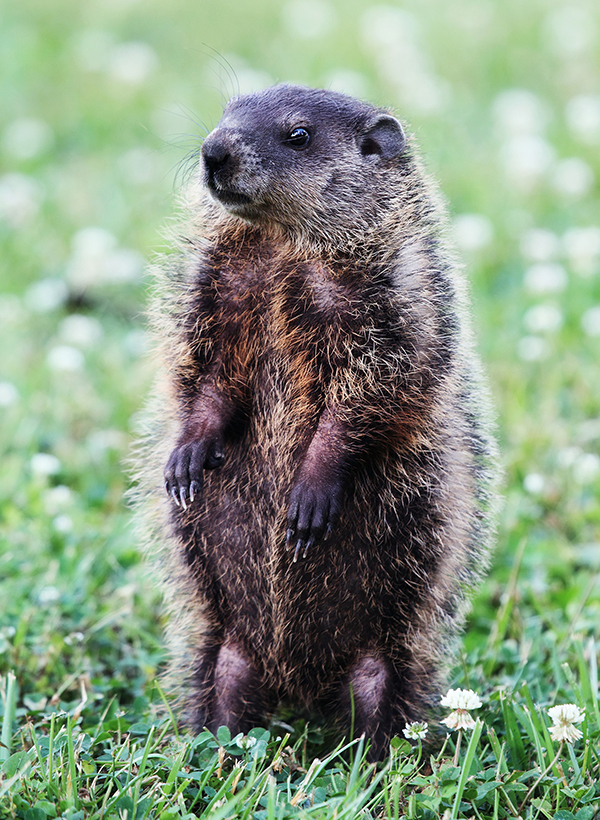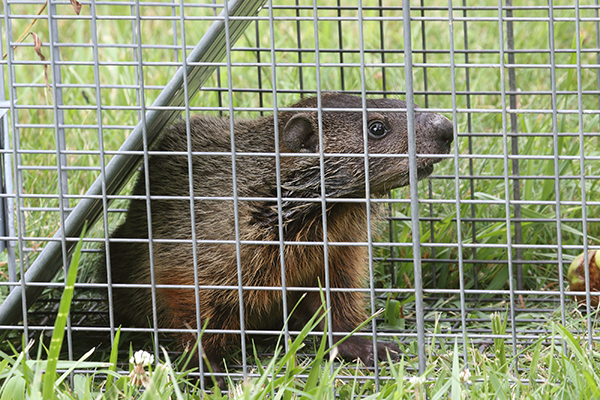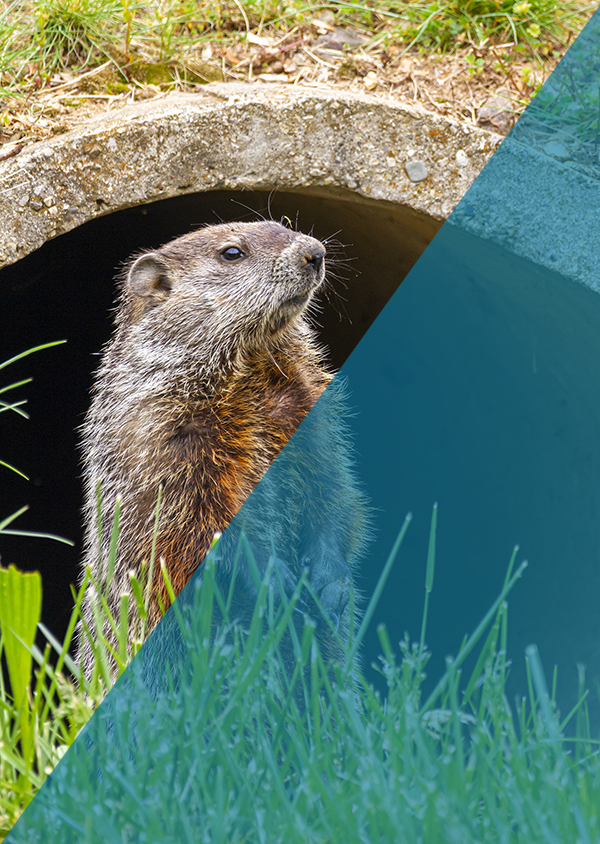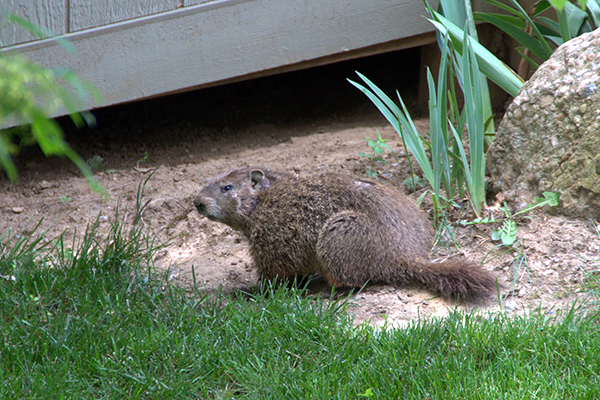
Freshly excavated dirt mounded beside a neat,
round burrow entrance, garden plants mysteriously
chewed down to mere stubs, or a deck and stoop
that unexpectedly reveal a “soft” or compromised
corner—these are undeniable signs, the
unmistakable calling cards, of a groundhog (aka
woodchuck) taking up residence. Trapper Joe’s
Wildlife Control, LLC offers comprehensive,
humane groundhog removal and effective long-
term control solutions specifically tailored for
homes, community spaces such as parks, and
various commercial properties throughout the
Greater Indianapolis area.
Our process involves meticulously mapping out
entire burrow systems, including identifying main
dens, secondary entrances, and all escape holes,
to ensure complete eradication of the groundhog
presence.
We then install robust, dig-proof exclusions for vulnerable structures like decks, sheds, stoops, and
crawlspaces, creating an impenetrable barrier. Our humane, regulation-compliant woodchuck pest removal
methods strictly prohibit the use of poisons or dangerous gas bombs, ensuring the welfare of the animals and
the safety of your property and the surrounding environment.
Owner-operator Joe Burkhart is not only fully licensed and insured, providing peace of mind to all our clients,
but also brings years of invaluable field experience dealing specifically with large, burrowing wildlife species
commonly found in Indiana soils. His expertise ensures that every groundhog situation is handled with
professionalism and an in-depth understanding of animal behavior. We consistently prioritize safety—both
for the animals and for our clients’ property—clear and transparent communication throughout the entire
process, and prevention-minded repairs and exclusion techniques. These proactive groundhog pest control
measures are designed to protect critical areas of your property such as foundations, stoops, sheds, and
intricate landscaping features for the long haul, saving you from future damage and costly repairs.
Beyond groundhog removal and exclusion, we also offer thorough cleanup services, removing debris and
waste, and perform backfill to restore ground grade and eliminate any voids or unstable areas left by the
burrows, effectively rehabilitating your landscape. When applicable, we provide insurance-ready photo
documentation of the damage and repairs, assisting you with any claims. Onsite assessments are readily
available for a nominal fee, a charge that is fully waived should you proceed with any of our professional
groundhog removal and control services. Final cost depends on den complexity, barrier length/depth, access,
and restoration needs. Prefer to phase it? We can prioritize urgent removal first, then schedule barrier work
and landscape fixes.
Ready to reclaim your yard from these burrowing pests? Contact us today to arrange your
comprehensive onsite estimate. Our wildlife trapping experts will carefully evaluate your unique situation,
identify active groundhog areas, and discuss the most effective, tailored solutions for your property. Or, if you
prefer, simply reach out to learn more about our full range of groundhog removal and control services.
Don't delay—proactive action is key to protecting your property from further damage and restoring the beauty
and stability of your landscape. Our dedicated animal removal team is here to help you every step of the way!
Call now to get started!

Recognizing signs of groundhog activity is crucial in protecting your property and garden from potential
damage. By identifying these indicators early, you can take swift action to minimize disruptions and prevent
further harm. Groundhogs, known for their burrowing habits, can cause significant issues if left unchecked.
Staying vigilant and knowing what to watch for will help you address the problem before it escalates. Here are
some common telltale signs to look out for:
Burrows → Groundhogs are well-known for digging extensive burrow systems underground. These intricate
tunnels can have multiple entrances and exits, often making them difficult to detect at first glance. You'll
typically find these burrows situated near convenient cover, such as fences, sheds, foundations, or even
under the roots of large trees. The primary entrance to a groundhog burrow is usually quite noticeable.
Mounds of Dirt → As groundhogs diligently excavate their burrows, they push the excess soil out onto the
surface. This activity results in distinctive mounds of freshly dug dirt accumulating around the burrow
entrances. These mounds can be a clear visual cue that a groundhog has set up residence nearby.
Damaged Plants → Groundhogs have a varied diet and are particularly fond of a wide range of vegetation. If
you notice your garden plants, including vegetables, fruits, flowers, or even ornamental shrubs, appearing
nibbled on, chewed down, or completely eaten, it's highly probable that groundhogs are the culprits
responsible for the damage. They can decimate a garden very quickly.
Tracks → Groundhogs leave behind distinct tracks that can help confirm their presence. Their front paws
typically show four toes, while their back paws have five. Keeping an eye out for these characteristic tracks in
soft soil, mud, or even dusty areas around your property can be a useful way to identify groundhog activity.
These tracks might also lead directly to their burrow entrances or feeding areas.
Sometimes, it can be difficult distinguishing one animal from the other based on the signs they leave behind.
Here are some comparisons of groundhog dens with those of other common critters (nuisance animal page)
you may encounter in your backyard:
 Groundhog Burrow → Round entrance, typically
8–12 inches in diameter, with a fan or mound of
fresh, granular soil at the opening. Pathways may
be worn into the grass.
Groundhog Burrow → Round entrance, typically
8–12 inches in diameter, with a fan or mound of
fresh, granular soil at the opening. Pathways may
be worn into the grass.
Skunk Burrow → Often smaller, with cone-shaped
lawn digs from foraging. A strong sulfur odor may
be present after a spray.
Fox Den → Larger opening near cover, frequently
with scattered bones or feathers. Tracks and scat
can indicate presence.
Mole Activity → Raised surface runs and small
mounds, but typically no large burrow entrances.
Unsure which animal you’re dealing with? We’ll confirm during the assessment and tailor the plan to the
species and site. Call now to schedule an estimate.
Groundhogs, also known as woodchucks, are strong diggers that seek three key things: secure shelter, accessible food, and well-drained soil for their dens. Decks, sheds, porch slabs, and stacked-stone walls offer cover, while vegetable gardens, clover-filled lawns, and flower beds provide food. Once established, their dens typically include multiple chambers and at least one escape tunnel, allowing groundhogs to move unseen through your yard until signs of damage appear. Here at Trapper Joe’s, we don’t just close the visible hole—we dismantle the system and keep it closed.
Seeing fresh soil piles, garden damage, or openings under your deck or stoop? Trapper Joe’s Wildlife Control, LLC humanely removes groundhogs, restores your property, and installs lasting defenses. We proudly serve Greater Indianapolis, including Avon, Franklin, Shelbyville, Fishers, Noblesville, Plainfield, Lawrence, Carmel, and surrounding communities. We also partner with HOAs, schools, parks, and facilities managers for site- wide burrow control. Schedule an onsite evaluation today (fee credited with any service) for a clear, durable plan for a groundhog-free yard.

We start by thoroughly inspecting your property to locate the main den entrance and all visible bolt holes or escape routes groundhogs use. We'll carefully map out their travel paths and document any existing damage with detailed photos. This comprehensive assessment allows us to provide you with a clear scope of work and a transparent, easy-to-understand estimate. If applicable, this estimate will also be insurance-friendly.
Our approach prioritizes humane methods. We
deploy species-appropriate live-capture traps,
strategically placed to ensure effectiveness and
safety. When site conditions permit, we also utilize
targeted one-way eviction devices that allow
groundhogs to leave but prevent their return.
Trap placement, protective covers, and frequent check schedules are all designed to minimize stress on the
animals and ensure the safety of your pets, always adhering strictly to Indiana regulations for wildlife
removal.
Before proceeding with any den closures or exclusion work, it is crucial to confirm that no animals remain within the burrow system. We meticulously verify this through various methods, including track checks, soil- set indicators, and possibly camera verification where appropriate, to prevent inadvertently sealing in any wildlife.
Once verified clear, we carefully collapse any existing voids within the burrow system. We then backfill these areas with compactable material to restore the original grade of your lawn or landscape and reduce future settlement. Where necessary, especially under skirting lines or foundations, we add compacted crushed stone in lifts to effectively deter groundhogs from re-excavating.
We install trench-and-skirt hardware cloth, which is either 1/4" galvanized or stainless steel, 12-18 inches below grade, and has an outward L-shaped footer that is 10-12 inches long to prevent tunneling. For decks and sheds, we use skirting with discreet access panels for future inspections. Crawl doors and vent screens are upgraded with wildlife-grade framing and fasteners. We seal penetrations at pipes and conduits with rigid backing and exterior-rated sealants. Optional garden defenses include perimeter fencing or buried skirts around raised garden beds.
Our service includes a thorough cleanup. We remove any nesting debris and tidy up soil piles left from the groundhog activity. We also correct any low spots or depressions created by their tunneling, which can sometimes impact drainage. If den areas have altered water flow, we’ll propose simple grading solutions or downspout adjustments to effectively direct water away from structures and foundations
Upon completion, you will receive a comprehensive package including before-and-after photos, detailed
barrier diagrams, and practical maintenance tips. These tips cover important aspects like vegetation
management, proper garden fencing, and controlling attractants to prevent future groundhog issues. Our
qualified sealing and barrier work is sometimes backed by an exclusion warranty, clearly detailed in your
estimate, providing you with peace of mind.
Don't wait for groundhogs to take over your yard! Take action today to protect your garden and landscaping.
Contact us today at 317-832-5840 for a low-fee, onsite assessment (fee waived with any service) to get
started with our animal trapping and removal services.
Woodchucks, also known as groundhogs, are remarkably adept at identifying and utilizing potential entry points or areas of shelter on your property. Even what might seem like minor gaps or inconspicuous features can quickly become ideal spots for them to establish nests or create travel routes. Pinpointing these potential problem areas is absolutely essential for effectively preventing infestations and maintaining the security of your property. Here are some of the most common areas you should inspect and protect:

Keep an eye out for open lattice work, sections of missing skirting, or any gaps present at ground level. These easily accessible, secluded spots are perfect for groundhogs looking to establish a hidden home beneath your elevated structures.
Groundhogs frequently take advantage of the loose, easy-to-dig backfill often found around the skids or foundation blocks of these secondary structures. This soft soil provides minimal resistance for burrowing.
Pay attention to any voids that may have formed along the edges of concrete slabs, as well as settlement cracks in stoops or patios. These seemingly minor imperfections can create inviting, sheltered entry points for groundhogs to tunnel under.
Den entrances are frequently discovered tucked away within the transitions and natural crevices of these landscape features. The layered structure of retaining walls offers ample opportunities for discreet burrowing.
Both natural hedgerows and man-made fence lines can inadvertently serve as concealed travel routes. Groundhogs utilize the cover these features provide to move discreetly, gaining access to gardens, flowerbeds, and other parts of your yard unnoticed.
These locations are particularly attractive to groundhogs because they often provide a dependable and convenient source of forage. The combination of readily available food and the potential for nearby cover makes them ideal spots for groundhogs seeking sustenance close to a safe haven.
Groundhogs may look harmless, but their burrowing habits can cause significant problems for homeowners and gardeners. From structural damage to landscape loss, these critters leave behind more than just tunnels. Here are some common issues groundhogs can create:
The extensive tunnel systems created by groundhogs can weaken the ground beneath various structures, potentially compromising the stability of stoops, sheds, and even short foundation runs. This can lead to costly repairs and safety concerns.
The entrances to groundhog burrows, often hidden by vegetation, and the possibility of collapsed tunnels just beneath the surface, can create unexpected trip hazards for both people and pets moving about the property.
Groundhog tunnels can inadvertently redirect water runoff, altering natural drainage patterns. This can lead to increased erosion in certain areas and, during colder months, contribute to frost heave, which can further damage foundations and paved surfaces.
Groundhogs are opportunistic feeders, and young plantings, tender vegetables, and many perennial flowers in gardens and landscaped areas are prime targets for their foraging habits, resulting in significant aesthetic and monetary loss.
Once a groundhog burrow is abandoned, its network of tunnels can become an inviting home for other
unwanted wildlife, such as skunks, opossums, foxes, or various species of snakes, leading to a new set of
pest problems.
By remaining vigilant and proactively addressing vulnerabilities in these areas, you can significantly reduce
the risk of woodchuck activity and help maintain a pest-free environment around your property. If they are
causing problems on your property, don’t wait until the animal damage escalates.
Contact our professional groundhog control services today to protect your home, garden, and landscape
from further harm. Call us now to schedule an inspection and get a tailored
solution for your needs!
Yes, we follow Indiana regulations for the ethical handling and disposition of groundhogs. During our assessment, we’ll walk you through the compliant approach tailored to your specific situation, ensuring both legal and humane standards are met.
For groundhogs, we install protective barriers with skirts that are typically 12–18 inches deep, including a 10– 12 inch outward “L” footer to prevent digging. The exact depth is carefully adjusted based on factors like soil type, the slope of the area, and the level of site pressure. This ensures the barrier is both effective and durable in keeping groundhogs out.
In many cases, yes. We use one-way devices that allow the groundhog to exit but block re-entry. Once we verify the den is vacated, we trench the area and install dig-proof skirting to prevent future burrowing. For added convenience, we can include a discreet access panel, making the solution both functional and visually unobtrusive.
Absolutely. We collapse and backfill inactive tunnels to restore the site and prevent the soil from settling over time. By regrading the area, we ensure the surface remains stable and visually seamless after the work is complete.
No, we do not use these methods. They are unsafe when used near structures, inhumane for the animals, and can even cause unintended consequences, such as forcing groundhogs into inaccessible cavities. We rely on methods that prioritize safety, ethics, and long-term effectiveness.
The timeline for removal varies depending on factors like the level of site pressure and the complexity of the den system. Once we set up equipment, many removals progress quickly. However, we keep you informed every step of the way, providing updates so you know exactly what’s happening throughout the process.
While new animals may attempt to den where a previous one succeeded, our sub-grade barriers and sealing techniques make it extremely difficult for them to re-enter. Additionally, we’ll offer recommendations for controlling attractants, such as food sources or sheltering materials, to reduce the likelihood of future attempts.
Yes, we can help safeguard your garden as well. We install garden skirts or low fencing to block groundhog access and may suggest layout adjustments to better protect high-value plants from damage. This way, your garden stays intact and thriving.
Greenfield, Indiana
Indianapolis, Indiana
View Our Library of Wildlife Blogs
December 17, 2025
The sound is unmistakable—a frantic scratching or scurrying noise coming from directly above your head. For many homeowners, this unsettling soundtrack is the first sign that their roof has become a cozy nursery for a
December 4, 2025
Central Indiana is known for its beautiful seasons and diverse ecosystems. From the rolling hills of Brown County to the bustling neighborhoods of Indianapolis, our region is teeming with life. While spotting a cardinal
November 18, 2025
Hearing strange noises from your attic at night can be unsettling. For many homeowners in Indiana, the culprit is often a surprisingly common visitor: the raccoon. These clever, masked animals are drawn to the shelter a
Fill Out & Submit Our Email Form!